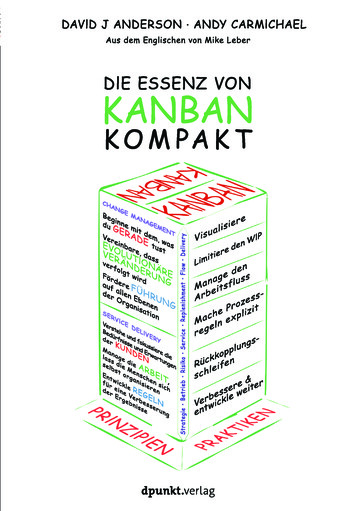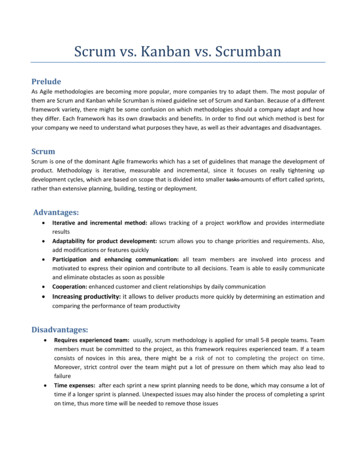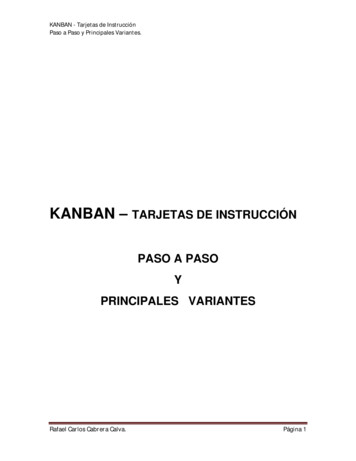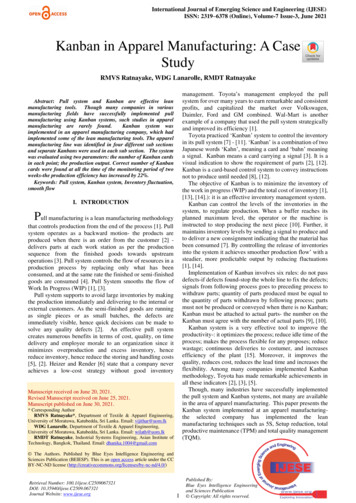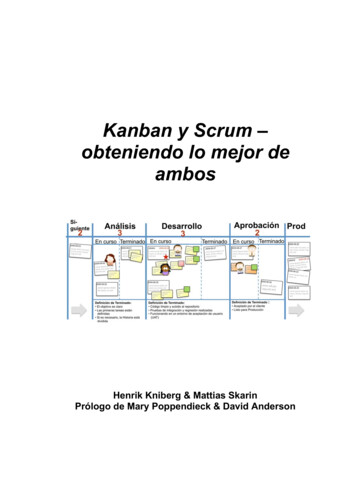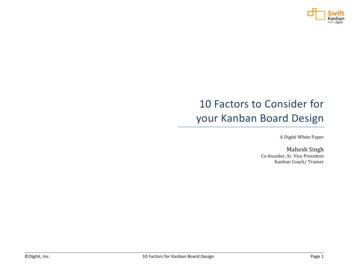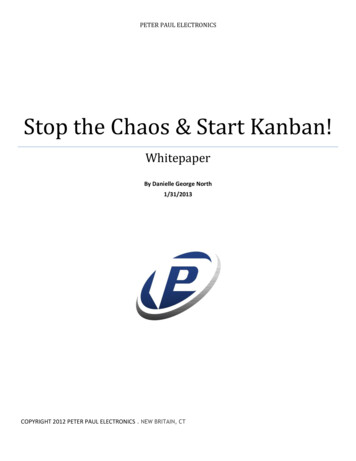
Transcription
PETER PAUL ELECTRONICSStop the Chaos & Start Kanban!WhitepaperBy Danielle George North1/31/2013COPYRIGHT 2012 PETER PAUL ELECTRONICS . NEW BRITAIN, CT
1ContentsKanban . 2Kanban Defined . 2Traditional Supply Chain . 2Example . 3What is the Difference? . 3Implementation of a Lean Supply Chain using Kanban . 49 Reasons Why to Implement Kanban? . 4Basic Kanban terms . 5Rules to be Successful . 5Best ways to keep the bins organized. 6Summary . 6
2KanbanBusinesses that rely on material movement are compelled to find ways to manage that material throughout their supplychains, improve quality, reduce cost, and deliver on time. That pursuit of excellence spawned lean manufacturing. Atraditional (non lean) supply chain pushes inventory through the system, causing rescheduling, expeditors, unexpectedsetups resulting in chaos, resulting in longer lead times, lower profits and dissatisfied customers. A lean supply chainpulls inventory through the system, creating one piece flow wherever possible and utilizing Kanban where flow is notpossible.Kanban DefinedKanban is a visual system to manage inventory. There are different ways you can signal when to produce more parts.There could be a line on a wall, an empty spot on a shelf, a card and many other options. A kanban card is the mostcommon method. When the card is pulled, that is the signal to replenish what has been consumed. It is used toeliminate overproduction and a way to link disconnected processes. It helps create a lean supply chain whicheliminates unevenness, instability and waste in all enterprises throughout the chain. Kanban helps to reduce leadtimes and improve on time delivery which ultimately improves customer satisfaction.Traditional Supply ChainA traditional (non lean) supply chain was intended to buffer you from demand and the Market place; therefore in aneffort to mitigate risk, each enterprise quotes long lead times so they don’t have to hold inventory and so they canmake the required parts in time to respond to purchase orders. The long lead times drive up the order quantities,which drive capacity spikes through the entire supply chain. The result is longer lead times due to the larger orderquantities. Profit is compromised at all companies in the supply chain as we reschedule and run off a hot list for thatweek. The early version was for the vendor to hold all the inventory which drove costs up, drove lead times up evenfarther as each company in the Supply Chain fails to meet the delivery requirement. This can cause the end customerto increase their order sizes and space them out further which causes more unevenness and capacity constraints thevicious circle ensues. Every part number in each enterprise goes through this cycle, encompassing potentiallythousands of parts and hundreds of customers at each company in the supply chain. There were partnerships in wordsonly between customers and suppliers.
3ExampleBefore implementing kanban, our lead time to our customers was approximately 10 weeks, if we did not have the partsin stock. We would start with the first up stream process (closest to the supplier) and push material through eachoperation, through the supply chain, to the customer. If we didn’t have the right parts in process, we then had to pushmore orders into the system, which would cause us to push orders aside to get another order through, it wouldn’t allowpeople to work efficiently they had to wait for a “hot list” creating more chaos. What is the alternative? A lean supplychain or material pull system.What is the Difference?The difference between the traditional (non lean) supply chain and a lean supply chain is remarkable .Thetraditional is based on a min/max level also knows as safety stock. We manufactured goods based on a forecastor historical data “just in case” we needed it. It also provided three ways to buffer companies from the marketplace. The first is inventory which was manufactured and stored base on min/max levels. By having thisexcess inventory you run the risk of product beginning obsolete due to engineering changes or changes in theMarket place. The second is excessive lead times which we needed to buffer from excess noise in the system(expediting, rescheduling, etc), change in demand, long setups and bad dates. The third and most expensive isexcess capacity this is when we run machines because we have the availability to run them even though we donot currently have any customer demand which will result in more inventory. With a lean supply chain we aremoving from “just in case” to “just in time” which means we will run the parts when we need it and only thequantity that we need. The lean supply chain that utilizes kanbans to link the customer to the supplier iseliminating the buffers of the traditional system. The lean supply chain is going to reduce the amount ofinventory because we are only replenishing what has been consumed. This will allow us to increase ourresponse to changes in the Market place and engineering changes because we do not have excess inventory. Itwill eliminate slow moving and obsolete parts. We are eliminating the excess noise in the system by creating akanban with our customers, this will allow us to reduce our lead times and allow people to work efficiently as
4opposed to a hot list. We are not going run machines that are not scheduled. We will move personnel aroundand train them in other areas that we have bins to fill so we have a cross functional work force.Implementation of a Lean Supply Chain using KanbanTo implement a lean supply chain, we create one piece flow. One piece flow is when parts move through differentoperations without any work-in-process. Some of the benefits are it builds quality into the process, it createsflexibility, high productivity and many more. When situations arise where we can not achieved one piece flow like longsetup times, the distance between the operations is too far, or some older technology is not designed to be utilized inthis way. These are situations where we utilize kanban supermarkets. These supermarkets contain right-sizedamounts of inventory that, allow seamless production flow to occur when it is not possible to physically link processes& achieve flow. This pulls material through the supply chain starting with the downstream process (closest to thecustomer), which pulls from the upstream processes (closest to the suppliers), pulling only the goods that are needed,only when they are needed and only the required amounts. Inventory is controlled to have the correct mix of allcomponents needed, in the right places, and we are pulling from the upstream processes. This results in reducing leadtimes down to only transit time. Since suppliers and customers are physically disconnected, it is not possible to createtrue production flow and reap the associated benefits like reducing work-in-process, improve quality by reducing scrap,improving on time delivery, and lead times could be as low as one or two days. By teaming together and linking ourprocesses with kanban supermarkets, we can strengthen the value stream and improve our total performance. Thenext step in the inventory supply chain is to evolve to consignment (which will allow better cash flow, even shorterlead times and a better competitive market).9 Reasons Why to Implement Kanban?The reasons to use a material pull system are:1. Ability to manage and balance the flow of material through the supply chain2. Elimination of the waste of handling, storing, expediting, obsolescence, repair, rework, facilities, equipmentand excess inventory (work-in-process and finished goods)3. Replenishing only what has been consumed instead of a forecasta. This is will allow a faster response time to change in the market place and thus keep current with themarket place.4. It provides a visual control of all resources which everyone can understand5. It is a simple process that allows flexibility and eliminates chaosa. Expediting, rescheduling, premium freight etc
56. Improved customer satisfactiona. Reduced lead timesb. Improved on time delivery performancec. Improved responsiveness7. Improved efficienciesa. Making only what is needed, when it is neededb. Reduce setup time by making part familiesc. Visual goal of success to eliminate stock outs8. Easier schedulinga. Common order quantities based on actual usageb. Visual signals to produce as opposed to relying on a forecast9. Higher profits (margins)a. Managing the 3 M’si. Manpower: used to effectively to reduce lead time inventory, and create a cross functionalwork forceii. Material: creating pull for raw and finished goods inventory.iii. Machine: building product based on demand (pull of a card) as opposed to a forecast.Basic Kanban terms Kanban Card - physical card that is used to prompt an action to buy or produce a part Bin - is the physical location of the inventory on a rack or shelf with an amount of inventory thatcorresponds with the quantity on the kanban card Bin System - a kanban system that utilizes bins and has one kanban card per bin Kanban Quantity – the amount consumed and how quickly we can fill it Cycle Time - The maximum time required for the kanban quantity to be refilled (time it takes to startthe raw material until it is put in the supermarket. Supermarket - The racks & shelves where the kanban inventory is kept Spike - A temporary or unusual increase in demand for a part which means we need to make moreproduct for a short period of timeRules to be SuccessfulIn order to be successful with kanban, rules like the some of the following must be implemented and adhered to.When the bin is empty, you must turn in the kanban card. The cards should not be turned in unless the bin is empty.Always pull from one bin at a time, until empty. To help employees conform to the rules, you may use a visual cue;you can create pull from here arrows and point it to the bin that should be pulled from. The most important rule is tokeep track of the kanban cards and turn them in on time. If a kanban card is lost or not turned in at the right time it
6will result in a stock out situation. A stock out situation is when all bins are out of parts, and will happen when theserules aren’t followed. When a stock out situation occurs, it creates capacity constraints on the supply chain and couldresult in pushing material as opposed to pulling material, resulting in a lot of expediting and chaos. . This is the onlymechanism that will prompt an action to fill the bin.Another rule is to always replenish a bin with the full quantity and establish rules when it isn’t possible, such asutilizing a partial fill notice to keep track of how many pieces you have replenished so far. If you don’t follow thisprocess, it may result in not putting the kanban card back on the shelf with the parts, thus when the bin empties,again no card will be triggered to replenish. Keeping the bins organized is a key concept to the success of this process.Best ways to keep the bins organized Keep the area and shelves around the bins neat & organized Keep cards & card holders in good condition Implement a card tracking system to ensure cards are not lost Keep the bin sections sized properly (no extra boxes outside of the bin locations) Rotate the stock properly, FIFO (First In First Out) Putting parts away correctly Keep an eye out for these potential problemsoParts are present in a location but the card is missingoCard is present in a location but there are no partsoPartial quantities in more than one binoParts that are put away in the wrong locationSummaryCreating kanbans with customers is a great way to reduce lead times and improve on time delivery. It goes beyondfocusing on an order and is a partnership between the customer and supplier. Each company yields benefits from thisprocess. The customer sees shorter lead times and increased on time delivery. The supplier sees the same benefitsand increases customer satisfaction. Kanban creates evenness but does not force you to be rigid. Kanban allowsflexibility as demand fluctuates. It’s a great way to reduce inventory and improve inventory turns. Implementingkanban is an excellent way to improve the business partnership and communication between both companies. This willgive you a competitive advantage which will maintain or increase your market share.For more information about solenoid valves, please contact Sales at info@peterpaul.com.
7ABOUT PETERPAULPeter Paul Electronics, founded in 1947, is a premier manufacturer of solenoid valves including high flow, explosionproof, high pressure, plastic, safety and mini valves. PeterPaul configures possibilities from solenoid valves thatoperate with power as low as 1/2 watt to pressure as high as 5000 psi. PeterPaul is located in New Britain,Connecticut and Fajardo, Puerto Rico. High quality design, innovative research and product development set PeterPaulapart from other manufactures. Continuous improvement is in the fabric of the company on all levels with peoplehaving years of experience, dedication and pride.###
Basic Kanban terms Kanban Card - physical card that is used to prompt an action to buy or produce a part Bin - is the physical location of the inventory on a rack or shelf with an amount of inventory that corresponds with the quantity on the kanban card Bin System - a kanban system that utili
